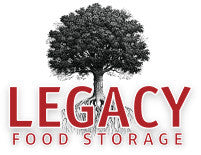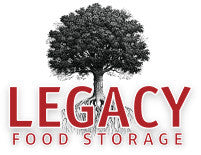Why Freeze-Dried Meals Top the List of Best Emergency Foods
Wandering around any food storage supply store, one of the first things you’ll notice is that there are a slew of different types of emergency food methods—canned foods, bulk grains, meals ready-to-eat, freeze dried and dehydrated meals, and emergency food bars, to name just a few. The eager prepper embarking on her self-reliance journey can easily become overwhelmed at the different options available. Which type of food storage is the best?
As you know, Legacy Premium offers emergency food that is a mix of freeze-dried and dehydrated foods. We have chosen this method because we think it is the best way to make food last an incredibly long time without having to compromise on taste or quality. In this post, we will make a case for freeze-dried meals and why we think they are the best food storage option available. The reasons are simple: Freeze-dried and dehydrated meals offer greater variety, nutrition, convenience, and shelf life than other methods of food storage.
Variety
Meal fatigue might sound like simply an inconvenience, but in real time, it can be a serious morale killer. If you store only large amounts of bulk items like wheat and beans and rice, you will end up eating most of the same foods over and over. The same is true of large number-10 cans of foods. If you open one of these cans, you usually have to eat its contents up within a day or so. As a result, you end up eating the same thing meal after meal or having to be really creative with the foods you make out of them…bean pancakes, anyone?
Freeze-dried and dehydrated meals offer a greater variety of foods than any other type. With freeze-dried foods, meals can be as varied in an emergency situation as they would be in real life. You might have stroganoff one night, corn chowder the next, and chili the next. The variety afforded by freeze-dried meals will ensure that eating will not be added to the list of chores your family has to worry about in an emergency situation.
Nutrition
Without variety in the food we eat, our health can suffer. If the emergency situation is prolonged and you are eating the same foods for a long period of time, you won’t be giving your body the full complement of vitamins it needs to function. According to a study done recently by Brigham Young University, a year supply of common bulk food storage items (400 lb wheat, 60 lb dry beans, 60 lb sugar, 16 lb powdered milk, 10 qt oil, and 8 lb salt) provides adequate calories but is lacking in calcium as well as vitamins A, C, B12, and E. In addition to the nutrient deficiencies of a diet made solely of this food, relying on wheat as your main emergency food can be a gamble. Many people have allergies to wheat and may not be aware of it until they are living on mostly wheat products. Only when they are subjecting their bodies to large amounts of it do their bodies exhibit their allergy.
The variety of foods in freeze-dried and dehydrated meals, including vegetables and fruits and even meats, allows for the ultimate mix of vitamins and minerals. More than perhaps any other food storage method, the freeze-drying process is particularly tailored to maintaining the original nutrients found in the food. In addition, the freeze-dried and dehydrated process makes it easier to tailor meals to specific needs, like gluten-free options that will help you avoid the problems associated with wheat allergies.
Convenience
Not only is freeze-dried emergency food more nutritious and varied than other types, it is also the winner in the convenience category. Consider with me for a moment the realities of possible emergency situations. It is likely that there may not be an easy way to cook and prepare meals from bulk foods. How will you make your wheat into flour for bread? How will you bake it? Without advanced preparations, you could be caught in a difficult situation.
Freeze-dried meals are an ideal emergency food type because they are ready to eat as is and require just water, which is something you should be storing in your emergency supply anyway.
In addition, with freeze-dried meals stored, you won’t have to worry about knowing how to cook things out of your food storage food. There may be some super savvy cooks out there who know how to whip up delicious homemade bread from memory, but I am not one of them. Are you?
Freeze-dried meals are also easier to store and move if necessary because the freeze-drying process makes foods super lightweight and compact, unlike big heavy cans of food.
Shelf Life
Freeze-dried and dehydrated foods also outclass the competition because of their potential for a very long shelf life. Meals ready-to-eat (MREs) typically have a shelf life of just three to five years, and canned foods with wet ingredients have a similarly short shelf life. Because of the efficiency of the freeze-drying process, 98% of the moisture is removed from freeze-dried foods so that the shelf life can be more like 25-30 years. Best of all, this preservation method does not require any preservatives.
You can probably now understand why we are so into freeze-dried products at Legacy Foods. Freeze-dried meals are the whole package when it comes to emergency food. They offer more variety, better nutrition, extreme convenience, and a uniquely reliable shelf-life. What else could you ask of your emergency food except that it also taste delicious? (Try one of our sample packs if you haven’t already, and you’ll see we’ve got that covered too.)
The post Why Freeze-Dried Meals Top the List of Best Emergency Foods appeared first on Buy Emergency Food.
Tags
- All
- 25 year food
- 25 year shelf life food
- 72 hour kit
- Best food storage types
- Best long-term food storage
- Blizzard preparedness
- Budgeting
- canning
- Certified GMO-free Emergency foods
- Certified GMO-free foods
- Coffee
- Comparison of emergency food methods
- Composting tips
- Dangers of genetically modified foods
- dehydrated food
- Edible Wild Plants
- emergcy preparedness
- Emergency Cooking
- Emergency Food
- Emergency food Christmas gifts
- emergency food storage
- Emergency Food Supply
- Emergency food supply recommendations
- Emergency Planning
- Emergency Preparedness
- Emergency preparedness advice
- emergency preparednesss
- Emergency Supplies
- Emergency supplies checklist
- Emergency Survival
- emergency survival gear
- Emergency survival kit checklist
- Emergency Survival skills
- exercise
- Family emergency preparedness
- Family emergency preparedness plan
- Family Preparedness
- Food Storage
- Food storage 25 year shelf life
- Food storage amounts
- Food storage Christmas
- Food storage containers long term
- Food Storage Secrets
- Food storage serving size
- Food storage types compared
- freeze dried food
- Freeze dried food storage
- freeze dried meats
- Freeze-dried emergency food storage
- Fruit Trees
- Gardening
- Getting Started
- Gluten-free food Storage
- Gourmet emergency food
- Healthy food storage
- How much emergency food to store
- Improved emergency preparedness
- Jared Markin
- Jared Matkin
- Legacy Premium
- Lessons learned from Hurricane Sandy
- Lessons learned from natural disasters
- long-term food storage
- Long-term Food Storage Guidelines
- Long-term Food Storage tips
- Long-term water storage
- Mental Emergency Preparedness
- Mental toughness
- Money-saving tips
- Natural disaster planning
- Natural Disasters
- Perfect Christmas gifts
- Pet Emergency preparedness checklist
- Pet Emergency preparedness kit
- Pet Emergency Survival tips
- Pets and Emergency Preparedness
- Plant Foraging
- portable solar panels
- portable solar power
- portable water filters
- protein drinks
- Risk of genetic modification
- Seed saving and storage
- Seed saving guide
- Self-reliance
- Self-reliant practices
- Shelf Life
- Solar Cooking
- Solar Ovens
- Special Dietary needs
- Stranded in a car in a blizzard
- Survival food
- Survival Gear
- survival kit
- Survival kits
- Survival Ovens
- Survival Skills
- survivalist gear
- suvival kit
- Tree Pruning tips
- Tree Trimming basics
- unique ideas
- water bottle with filter
- water filter
- water filter straw
- water filters
- Water Filtration
- water pitcher with filter
- water pitchers with filters
- Water purification
- Wild Food Foraging
- Winter composting
- Winter driving
- Winter preparedness tips
- Winter storm preparedness tips
- Winter Survival







